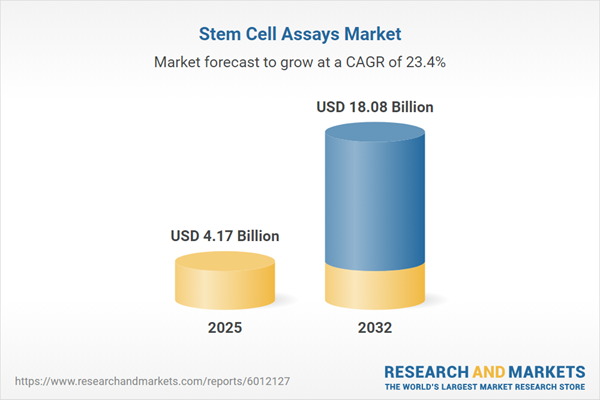Speak directly to the analyst to clarify any post sales queries you may have.
The stem cell assays market is experiencing rapid evolution, offering critical support to sectors focused on disease modeling, regenerative medicine, and advanced drug development. Senior decision-makers must navigate new technologies, shifting regulations, and complex supply chains to capture market opportunities and sustain competitive advantage.
Market Snapshot: Stem Cell Assays Market Growth Trajectory
The Stem Cell Assays Market achieved significant expansion, rising from USD 3.37 billion in 2024 to USD 4.17 billion in 2025. Projected CAGR stands at 23.36%, with market value anticipated to reach USD 18.08 billion by 2032. Robust demand for advanced cell-based platforms and integration of high-throughput systems are reshaping the competitive landscape, as stakeholders accelerate innovation and regional manufacturing capacity grows.
Scope & Segmentation of the Stem Cell Assays Market
- Product Types: Consumables (flasks, microplates, tubes), instruments (flow cytometer, microscope, PCR system), reagents (antibodies, kits, media), and software (data analysis platform, imaging software).
- Technologies: Flow cytometry (cell analysis, sorting), high content screening (live cell imaging, multiplex screening), imaging (fluorescence, phase contrast), polymerase chain reaction (digital, quantitative), spectroscopy (absorption, Raman).
- Cell Types: Adult stem cells (hematopoietic, mesenchymal), embryonic stem cells, induced pluripotent stem cells, neural stem cells.
- Applications: Cell therapy research, drug screening, gene editing, regenerative medicine, toxicology testing.
- End Users: Academic and research institutes, biotechnology companies, contract research organizations, hospitals and clinics, pharmaceutical companies.
- Assay Formats: High throughput, three dimensional, two dimensional.
- Services: Consulting, custom, standard services.
- Regions: Americas (including North America and Latin America), Europe, Middle East & Africa, Asia-Pacific (with key countries such as the United States, China, Germany, Japan, Brazil, Australia, India, and more).
- Leading Companies: Thermo Fisher Scientific Inc., Merck KGaA, STEMCELL Technologies Inc., Corning Incorporated, Danaher Corporation, Lonza Group AG, Bio-Rad Laboratories, Inc., PerkinElmer, Inc., PromoCell GmbH, Bio-Techne Corporation.
Key Takeaways for Senior Decision-Makers
- Stem cell assays are transforming biomedical research paradigms, allowing organizations to reduce reliance on animal models and achieve more clinically relevant results.
- The adoption of high-throughput and three-dimensional formats enhances reproducibility, while powerful data analytics software improves workflow efficiency and insight extraction.
- Collaborative networks between academia, biotech firms, and contract research organizations foster the integration of stem cell assay technologies into early-stage pipelines.
- Strategic partnerships and regional supply chain realignment support risk mitigation against external pressures, enabling operational agility and cost control.
- Emerging markets in the Asia-Pacific and Latin America regions offer expanded manufacturing opportunities and access to skilled personnel, supporting global scalability.
Tariff Impact: Navigating New U.S. Tariff Adjustments
The recent U.S. tariff changes have added complexity to global supply chains for assay components, impacting costs for consumables, specialized reagents, and instruments. Organizations are actively engaging in dual-sourcing and regional production, working alongside policymakers to ease critical research imports and stabilize operational budgets. This shift is accelerating investment in domestic manufacturing and creating a more resilient ecosystem capable of withstanding ongoing trade uncertainties.
Methodology & Data Sources
This report draws upon a robust methodological foundation, featuring primary interviews with life science executives and technical experts. Comprehensive secondary research includes peer-reviewed publications, patents, regulatory filings, and corporate disclosures. Quantitative data triangulation and cross-referenced validation ensure integrity and relevance of strategic insights.
Why This Report Matters in the Stem Cell Assays Market
- Delivers comprehensive analysis of evolving technologies, segmentation opportunities, and regional trends to inform investment and strategy decisions.
- Equips senior leaders with actionable intelligence on regulatory impacts, supply chain adaptation, and innovation trends for effective market entry or expansion.
Conclusion
The stem cell assays market is positioned for sustained growth as technological, regulatory, and geographic factors drive innovation and operational resilience. Informed strategies and partnerships will be crucial for capturing value and navigating this evolving landscape.
Additional Product Information:
- Purchase of this report includes 1 year online access with quarterly updates.
- This report can be updated on request. Please contact our Customer Experience team using the Ask a Question widget on our website.
Table of Contents
3. Executive Summary
4. Market Overview
7. Cumulative Impact of Artificial Intelligence 2025
List of Figures
Samples

LOADING...
Companies Mentioned
The key companies profiled in this Stem Cell Assays market report include:- Thermo Fisher Scientific Inc.
- Merck KGaA
- STEMCELL Technologies Inc.
- Corning Incorporated
- Danaher Corporation
- Lonza Group AG
- Bio-Rad Laboratories, Inc.
- PerkinElmer, Inc.
- PromoCell GmbH
- Bio-Techne Corporation
Table Information
| Report Attribute | Details |
|---|---|
| No. of Pages | 194 |
| Published | October 2025 |
| Forecast Period | 2025 - 2032 |
| Estimated Market Value ( USD | $ 4.17 Billion |
| Forecasted Market Value ( USD | $ 18.08 Billion |
| Compound Annual Growth Rate | 23.3% |
| Regions Covered | Global |
| No. of Companies Mentioned | 11 |









